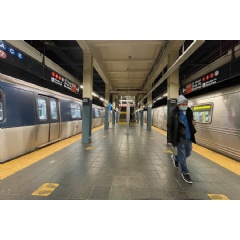Has remote work changed how people travel in the U.S?
A new study finds sustained pattern changes — with a lot of regional variation.

The prevalence of remote work since the start of the Covid-19 pandemic has significantly changed urban transportation patterns in the U.S., according to new study led by MIT researchers.
The research finds significant variation between the effects of remote work on vehicle miles driven and on mass-transit ridership across the U.S.
“A 1 percent decrease in onsite workers leads to a roughly 1 percent reduction in [automobile] vehicle miles driven, but a 2.3 percent reduction in mass transit ridership,” says Yunhan Zheng SM ’21, PhD ’24, an MIT postdoc who is co-author of a the study.
“This is one of the first studies that identifies the causal effect of remote work on vehicle miles traveled and transit ridership across the U.S.,” adds Jinhua Zhao, an MIT professor and another co-author of the paper.
By accounting for many of the nuances of the issue, across the lower 48 states and the District of Columbia as well as 217 metropolitan areas, the scholars believe they have arrived at a robust conclusion demonstrating the effects of working from home on larger mobility patterns.
The paper, “Impacts of remote work on vehicle miles traveled and transit ridership in the USA,” appears today in the journal Nature Cities. The authors are Zheng, a doctoral graduate of MIT’s Department of Civil and Environmental Engineering and a postdoc at the Singapore–MIT Alliance for Research and Technology (SMART); Shenhao Wang PhD ’20, an assistant professor at the University of Florida; Lun Liu, an assistant professor at Peking University; Jim Aloisi, a lecturer in MIT’s Department of Urban Studies and Planning (DUSP); and Zhao, the Professor of Cities and Transportation, founder of the MIT Mobility Initiative, and director of MIT’s JTL Urban Mobility Lab and Transit Lab.
The researchers gathered data on the prevalence of remote work from multiple sources, including Google location data, travel data from the U.S. Federal Highway Administration and the National Transit Database, and the monthly U.S. Survey of Working Arrangements and Attitudes (run jointly by Stanford University, the University of Chicago, ITAM, and MIT).
The study reveals significant variation among U.S. states when it comes to how much the rise of remote work has affected mileage driven.
“The impact of a 1 percent change in remote work on the reduction of vehicle miles traveled in New York state is only about one-quarter of that in Texas,” Zheng observes. “There is real variation there.”
At the same time, remote work has had the biggest effect on mass-transit revenues in places with widely used systems, with New York City, Chicago, San Francisco, Boston, and Philadelphia making up the top five hardest-hit metro areas.
The overall effect is surprisingly consistent over time, from early 2020 through late 2022.
“In terms of the temporal variation, we found that the effect is quite consistent across our whole study period,” Zheng says. “It’s not just significant in the early stage of the pandemic, when remote work was a necessity for many. The magnitude remains consistent into the later period, when many people have the flexibility to choose where they want to work. We think this may have long-term implications.”
Additionally, the study estimates the impact that still larger numbers of remote workers could have on the environment and mass transit.
“On a national basis, we estimate that a 10 percent decrease in the number of onsite workers compared to prepandemic levels will reduce the annual total vehicle-related CO2 emissions by 191.8 million metric tons,” Wang says.
The study also projects that across the 217 metropolitan areas in the study, a 10 percent decrease in the number of onsite workers, compared to prepandemic levels, would lead to an annual loss of 2.4 billion transit trips and $3.7 billion in fare revenue — equal to roughly 27 percent of the annual transit ridership and fare revenue in 2019.
“The substantial influence of remote work on transit ridership highlights the need for transit agencies to adapt their services accordingly, investing in services tailored to noncommuting trips and implementing more flexible schedules to better accommodate the new demand patterns,” Zhao says.
The research received support from the MIT Energy Initiative; the Barr Foundation; the National Research Foundation, Prime Minister’s Office, Singapore under its Campus for Research Excellence and Technological Enterprise program; the Research Opportunity Seed Fund 2023 from the University of Florida; and the Beijing Social Science Foundation.
( Press Release Image: https://photos.webwire.com/prmedia/7/320282/320282-1.jpg )
WebWireID320282
This news content was configured by WebWire editorial staff. Linking is permitted.
News Release Distribution and Press Release Distribution Services Provided by WebWire.